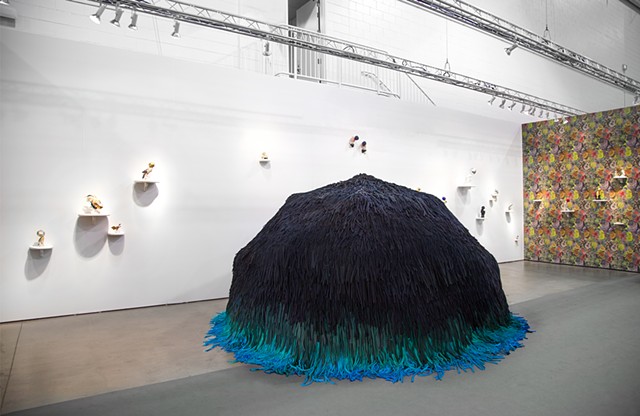Tell it to the Birds
Tell it to the Birds is an attempt to bridge the experiential gap between human and non-human animal minds.
Birds sing to communicate with each other; we can only imagine what their subjective experiences of their songs might be. Although, birdsong is not intended for humans, it has long fascinated us, inspiring musicians like Vivaldi, Beethoven, Pink Floyd and Kate Bush to ‘quote’ birds in their compositions.
Despite the important role birds play in our environment and in popular culture, they are being pushed to the edge by human expansion. Ecological threats such as habitat loss, oil and gas development, and climate change now threaten 12% of birds worldwide and over 30% of domestic US bird species. Eleven of these unique birds and their calls are featured in Tell it to the Birds.
Participants are invited to enter into a dwelling-like dome, the form of which suggests animal-built structures and utopian architectural forms. Within the darkened, private interior, each person is invited to ‘tell it to the birds‘ — to confess something to the natural world that they feel other people or the human world might not understand. Special audio-processing software “translates" their words into birdsong, heard both inside and outside the structure -- yet only the speaker knows the meaning of their song.
Though the shared ‘secret’ is entirely up to the participant — be it mundane or profound — the suggestion remains that we may wish to confess something to the natural world about our relationship with nature itself — to speak of a lack, a trespass, a neglect. It is common to hear that many of us felt closer to nature when we were children. Literally closer to the earth, we crouched downward to examine beetles, pick up feathers and to smell dense piles of moss. We picked dandelions that grew up through the pavement. We were not concerned about getting dirt under our nails. As adults, however, many of us find it is no longer ‘sensible’ to investigate the earth. We no longer speak back to birds. Many of us have forgotten our intimate connection to our former world, having been tasked by ‘growing-up’ – moving from the wild ways of childhood into the studied and arranged culture of the adult.
I would like to argue that this is a false dichotomy. Even in the most urban of cities, goldfinches migrate through in the fall, coyotes run the railroad tracks, and spiders weave intricate webs on the windows of skyscrapers. And even within those skyscrapers, nature is alive because we are still (and always) embedded within our animal bodies. We are blood, bone, guts, bacteria — we are multitudes, ourselves an ecosystem — mortal and fully animal, no matter how our culture may try to ignore this fact. And so, I suggest with this installation, the need to reclaim our animal selves, and to recognize and respect our kinship with the others with whom we share this planet.
By infusing human meaning and emotion into the language of birds, traditional semantics become destabilized. This opacity between human and bird speech is a poetry of slippage. Though the act of translation, by its nature, is always inadequate, it also creates an open-ended and unpredictable channel for connection, suggesting an implicit kinship between speakers. This act recognizes the inviolable difference of the other, while also attempting the first and necessary step of any boundary crossing.
Tell it to the Birds raises questions about what we mean when we say 'language.' Linguists such as Noam Chomsky assert that language exists in an evolutionary continuum from non-human to human animals. Once claimed to be something that separated humans from animals, language and the need to communicate is something that we now know we share with most, if not all, living beings. I'm interested in what it means to translate across the species boundary, beyond an anthropocentric perspective; to communicate with and attempt to understand new kinds of mind, intelligence and culture in non-human species — and the immeasurable value that we might find there.
This act of cross-species empathy is so deeply important today, because how human beings feel about a species is becoming one of the most important factors in that species’ survival. Human imagination has become an ecological force. Taking cues from eco-phenomenology and bio-semiotics, I suggest that — while we may never be able to completely understand the subjective experience of mind, or umwelt, of a bird (or any other being) — by experiencing our own words spoken in the voice of these beautiful others, a tenuous thread of connection is extended across that gap.
